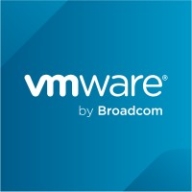

Red Hat OpenShift and VMware Cloud Foundation compete in the cloud-native platform space, with a focus on containerization and data center solutions respectively. OpenShift appears to have an advantage in container orchestration and integration, while VMware contends with its comprehensive virtualization capabilities.
Features: OpenShift excels in CI/CD integration, streamlined deployment with Jenkins and Kubernetes, and robust security measures. Its container orchestration simplifies cloud-native application deployments. VMware Cloud Foundation, on the other hand, shines with its virtualization features, network configuration, and lifecycle management, offering a complete solution for managing data centers.
Room for Improvement: OpenShift could enhance user-friendliness in its documentation and provide better debugging support. Users find the scaling and template creation challenging and desire improvements in cross-cluster management. VMware Cloud Foundation faces criticism for its pricing and deployment complexity, and users call for greater flexibility in integration with non-VMware tools.
Ease of Deployment and Customer Service: OpenShift is noted for its flexible deployment across various cloud environments but requires considerable expertise for setup. Its support receives mixed reviews, especially regarding response times. VMware Cloud Foundation offers unified management but struggles with consistency in solving complex support queries quickly.
Pricing and ROI: OpenShift’s pricing is considered high but justified given its features, potentially offering cost benefits when bundled with other Red Hat products. VMware Cloud Foundation is viewed as expensive, leading users to seek more competitive rates. Both provide good ROI by streamlining workflows, though VMware's extensive services contribute to its costliness.
With OpenShift combined with IBM Cloud App integration, I can spin an integration server in a second as compared to traditional methods, which could take days or weeks.
Moving to OpenShift resulted in increased system stability and reduced downtime, which contributed to operational efficiency.
It is always advisable to get the bare minimum that you need, and then add more when necessary.
VMware Cloud Foundation allows cost and time savings by quickly deploying infrastructure requests and integrating automatic ticketing and backup services.
In terms of ROI, although VMware Cloud Foundation is expensive, it saves time in most cases, which indirectly saves costs for users.
Red Hat's technical support is responsive and effective.
I have been pretty happy in the past with getting support from Red Hat.
Red Hat's technical support is good, and I would rate it a nine out of ten.
There are times when support is unclear, and even VMware support personnel may lack familiarity with certain parts, causing difficulties.
Based on my nine years of experience with VMware, I would evaluate their technical support as effective.
The technical support from VMware Cloud Foundation deserves a nine out of ten rating.
The on-demand provisioning of pods and auto-scaling, whether horizontal or vertical, is the best part.
OpenShift's horizontal pod scaling is more effective and efficient than that used in Kubernetes, making it a superior choice for scalability.
Red Hat OpenShift scales excellently, with a rating of ten out of ten.
When more hosts are added, performance goes slow.
VMware Cloud Foundation supports scalability and company growth.
VMware Cloud Foundation is quite scalable, receiving a rating of eight and a half to nine out of ten.
It provides better performance yet requires more resources compared to vanilla Kubernetes.
I've had my cluster running for over four years.
It performs well under load, providing the desired output.
The stability of VMware Cloud Foundation is very high.
If one component fails to operate in a timely manner, the entire infrastructure can go down because everything is interconnected.
I am currently satisfied with the stability of VMware Cloud Foundation, though having started only two to three months ago, I am still in the monitoring phase.
Learning OpenShift requires complex infrastructure, needing vCenter integration, more advanced answers, active directory, and more expensive hardware.
Red Hat OpenShift's biggest disadvantage is they do not provide any private cloud setup where we can host on our site using their services.
We should aim to include VMware-like capabilities to be competitive, especially considering cost factors.
VMware Broadcom needs to include auto resource allocation at the VM levels.
The maintenance cost has increased significantly, especially after Broadcom acquired VMware, with a shift from socket-based licensing to core-based licensing.
Each user needs deep knowledge of every aspect of virtualization.
Initially, licensing was per CPU, with a memory cap, but the price has doubled, making it difficult to justify for clients with smaller compute needs.
Red Hat can improve on the pricing part by making it more flexible and possibly on the lower side.
The cost of OpenShift is very high, particularly with the OpenShift Plus package, which includes many products and services.
The cost has become very high, especially after Broadcom's acquisition, altering the licensing model to a more expensive core-based system.
When comparing prices of both clouds, AWS is cheaper because they offer a free section for practice.
The price is quite higher than some other vendors.
Because it was centrally managed in our company, many metrics that we had to write code for were available out of the box, including utilization, CPU utilization, memory, and similar metrics.
The concept of containers and scaling on demand is a feature I appreciate the most about Red Hat OpenShift.
A valuable feature of Red Hat OpenShift is its ability to handle increased loads by automatically adding nodes.
The solution now offers auto-deployment of VMs.
All features of VMware Cloud Foundation are valuable to us, as it covers every industry standard protocol and requirement protocol.
VMware Cloud Foundation allows for extensive customization, aligning with our customer requirements.
| Product | Market Share (%) |
|---|---|
| VMware Cloud Foundation | 19.5% |
| Red Hat OpenShift | 5.7% |
| Other | 74.8% |


| Company Size | Count |
|---|---|
| Small Business | 17 |
| Midsize Enterprise | 4 |
| Large Enterprise | 40 |
| Company Size | Count |
|---|---|
| Small Business | 8 |
| Midsize Enterprise | 3 |
| Large Enterprise | 27 |
Red Hat OpenShift offers a robust, scalable platform with strong security and automation, suitable for container orchestration, application deployment, and microservices architecture.
Designed to modernize applications by transitioning from legacy systems to cloud-native environments, Red Hat OpenShift provides powerful CI/CD integration and Kubernetes compatibility. Its security features, multi-cloud support, and source-to-image functionality enhance deployment flexibility. While the GUI offers user-friendly navigation, users benefit from its cloud-agnostic nature and efficient lifecycle management. However, improvements are needed in documentation, configuration complexity, and integration with third-party platforms. Pricing and high resource demands can also be challenging for wider adoption.
What are the key features of Red Hat OpenShift?Red Hat OpenShift is strategically implemented for diverse industries focusing on container orchestration and application modernization. Organizations leverage it for migrating applications to cloud-native environments and managing CI/CD pipelines. Its functionality facilitates efficient resource management and microservices architecture adoption, supporting enterprise-level DevOps practices. Users employ it across cloud and on-premises platforms to drive performance improvements.
VMware Cloud Foundation makes it easy to deploy and run a hybrid cloud. VMware Cloud Foundation provides integrated cloud infrastructure (compute, storage, networking, and security) and cloud management services to run enterprise applications in both private and public environments.
We monitor all Hybrid Cloud Computing Platforms reviews to prevent fraudulent reviews and keep review quality high. We do not post reviews by company employees or direct competitors. We validate each review for authenticity via cross-reference with LinkedIn, and personal follow-up with the reviewer when necessary.